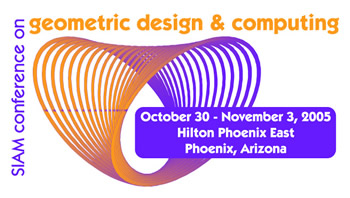
Sponsored by SIAM Activity Group on Geometric Design
Title: Graphics Hardware as a High-end Computational Resource
Short Course Organizer(s): Tor Dokken, SINTEF ICT, Department of Applied Mathematics, Oslo Norway [email protected]
Rationale: With the introduction in 2003 of standard GPUs (Graphics Processor Units) with 32 bit floating point numbers and programmable Vertex and Fragment processors, the processing power of the GPU was made available to non-graphics applications. As the GPU is aimed at computer graphics, the concepts in GPU-programming are based on computer graphics terminology, and the strategies for programming have to be based on the architecture of the graphics pipeline.
Instructor(s): Tor Dokken, Chief Scientist in SINTEF ICT, Department of Applied
Mathematics, Professor II (part time) at the Center of "Mathematics
for Applications" at the University of Oslo, and Professor II (part
time) at Narvik University College, Norway. Cand. Real. (Master's
degree) in Numerical Mathematics (1978) and Dr. Philos. (1997)
Institute of Informatics, University of Oslo. Employed at SINTEF in
Oslo since 1978.
Main focus of work has been related to CAGD with the focus on
intersection algorithms, approximate implicitization and computer
graphics. Currently coordinating the Norwegian GPU-project.
Secretary in the SIAM Activity Group on Geometric Design.
Trond Runar Hagen, Research Scientist in SINTEF ICT, Department of
Applied Mathematics. Graduated 2001 with a Master's degree from the
University College of Narvik, Norway in 2001. Employed by SINTEF in
2001. His main focus of work is within visualization and computer
graphics with the focus on none-traditional uses of the GPU.
Course Description: At SINTEF in Norway, a 4-year strategic institute project (2004-2007) "Graphics hardware as a high-end computational resource" http://www.math.sintef.no/gpu/, aims at making GPUs available as a computational resource both to academia and industry. The project addresses application areas of GPUs within geometry, simulation, image processing and visualization, and has already demonstrated performance increases between 10x and 20x for classes of explicit finite difference schemes for solving partial differential equations. The combination of the computational power of commodity GPUs, simulation problems, representation of complex geometric structures and innovative visualization, has the potential of introducing applications on standard PCs that until now have been available only through the use of high-performance computing.
The short course will start with a general introduction to the potential of GPU-programming. Then we will address the graphics pipeline, since understanding the graphics pipeline is essential in GPU-programming. We will explain the potential and limitation of textures, fragment shaders and vertex shaders, and illustrate alternative approaches using simple examples. The short course will be concluded by examples of more complex applications using multiple shaders both for computations and visualization. Examples will come from CAGD, simulation and image processing.
Level of the Material: The material of the short course is aimed at beginners within GPU-programming and the use of GPUs as a computational resource.
Target Audience: The target audience is professionals from research and industry interested in an introduction to the potential of the GPU as a computational resource.
Recommended Background: The recommended background is computer graphics and applied mathematics, but not at an expert level.
For general information on general purpose processing on GPUs consult http://www.gpgpu.org
Course Outline:
1. Introduction to the GPU as a computational resource. (30
minutes).
2. The graphics pipeline and GPU-programming (60 minutes)
3. Examples showing applications using the GPU as a computational
resource (45 minutes)